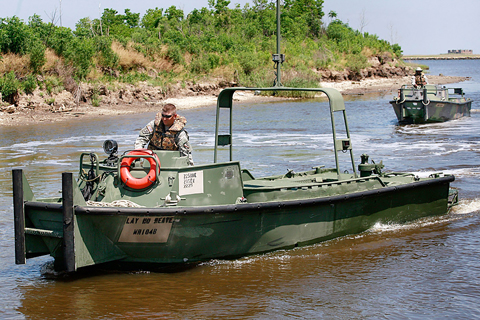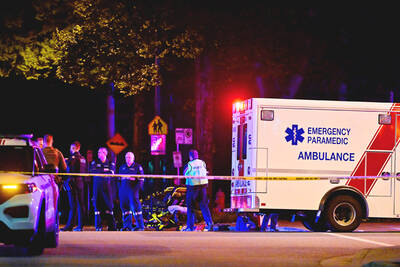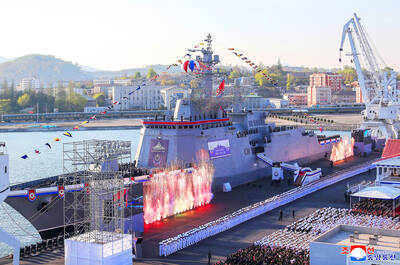The deadly blowout of an oil rig in the Gulf of Mexico was triggered by a bubble of methane gas that escaped from the well and shot up the drill column, expanding quickly as it burst through several seals and barriers before exploding, according to interviews with rig workers conducted during BP’s internal investigation.
While the cause of the explosion is still under investigation, the sequence of events described in the interviews provides the most detailed account of the April 20 blast that killed 11 workers and touched off the underwater gusher that has poured more than 11.36 million liters of crude into the Gulf.
Portions of the interviews, two written and one taped, were described in detail by Robert Bea, a University of California Berkeley engineering professor who serves on a National Academy of Engineering panel on oil pipeline safety and worked for BP PLC as a risk assessment consultant during the 1990s. He received them from industry friends seeking his expert opinion.

PHOTO: AFP
A group of BP executives were on board the Deepwater Horizon rig celebrating the project’s safety record, the transcripts said.
Meanwhile, far below, the rig was being converted from an exploration well to a production well.
Based on the interviews, Bea believes that the workers set and then tested a cement seal at the bottom of the well. Then they reduced the pressure in the drill column and attempted to set a second seal below the sea floor. A chemical reaction caused by the setting cement created heat and a gas bubble, which destroyed the seal.
Deep beneath the seafloor, methane is in a slushy, crystalline form. Deep sea oil drillers often encounter pockets of methane crystals as they dig into the earth.
As the bubble rose up the drill column from the high-pressure environs of the deep to the less pressurized shallows, it intensified and grew, breaking through various safety barriers, Bea said.
“A small bubble becomes a really big bubble,” Bea said. “So the expanding bubble becomes like a cannon shooting the gas into your face.”
Up on the rig, the first thing workers noticed was the sea water in the drill column suddenly shooting back at them, rocketing 73m in the air, he said. Then gas surfaced. Then oil.
“What we had learned when I worked as a drill rig laborer was swoosh, boom, run,” Bea said. “The swoosh is the gas, boom is the explosion and run is what you better be doing.”
The gas then flooded into an adjoining room that had exposed ignition sources, he said.
“That’s where the first explosion happened,” said Bea, who worked for Shell Oil in the 1960s during the last big northern Gulf of Mexico oil well blowout. “The mud room was next to the quarters where the party was. Then there was a series of explosions that subsequently ignited the oil that was coming from below.”
According to one interview transcript, a gas cloud covered the rig, causing giant engines on the drill floor to run too fast and explode. The engines blew off the rig and set “everything on fire,” the account said. Another explosion below blew more equipment overboard.
The BP executives were injured, but survived, according to one account. Nine rig crew on the rig floor and two engineers died.
On Friday, a BP-chartered vessel lowered a 100-tonne concrete-and-steel vault onto the ruptured well, an important step in a delicate and unprecedented attempt to stop most of the gushing crude fouling the sea.
“We are essentially taking a four-storey building and lowering it 1,500m and setting it on the head of a pin,” BP spokesman Bill Salvin said.
Underwater robots guided the 12m tall box into place in a slow-moving drama. Now that the contraption is on the seafloor, workers will need at least 12 hours to let it settle and make sure it’s stable, before the robots can hook up a pipe and hose that will funnel the oil up to a tanker.
“It appears to be going exactly as we hoped,” Salvin said on Friday afternoon, shortly after the four-story device hit the seafloor. “Still lots of challenges ahead, but this is very good progress.”
By today, the box the size of a house could be capturing up to 85 percent of the oil.
The task became increasingly urgent as toxic oil crept deeper into the bays and marshes of the Mississippi Delta.
A sheen of oil began arriving on land last week and crews have been laying booms, spraying chemical dispersants and setting fire to the slick to try to keep it from coming ashore. Now the thicker, stickier goo — arrayed in vivid, brick-colored ribbons — is drawing ever closer to Louisiana’s coastal communities.
There are still untold risks and unknowns with the containment box. The approach has never been tried at such depths, where the water pressure is enough to crush a submarine, and any wrong move could damage the leaking pipe, making the problem worse. The seafloor is pitch black and the water murky, though lights on the robots illuminate the area where they are working.
If the box works, another one will be dropped onto a second, smaller leak at the bottom of the Gulf.
At the same time, crews are drilling sideways into the well in hopes of plugging it up with mud and concrete. They are also working on other ways to cap it.

Archeologists in Peru on Thursday said they found the 5,000-year-old remains of a noblewoman at the sacred city of Caral, revealing the important role played by women in the oldest center of civilization in the Americas. “What has been discovered corresponds to a woman who apparently had elevated status, an elite woman,” archeologist David Palomino said. The mummy was found in Aspero, a sacred site within the city of Caral that was a garbage dump for more than 30 years until becoming an archeological site in the 1990s. Palomino said the carefully preserved remains, dating to 3,000BC, contained skin, part of the

TRUMP EFFECT: The win capped one of the most dramatic turnarounds in Canadian political history after the Conservatives had led the Liberals by more than 20 points Canadian Prime Minister Mark Carney yesterday pledged to win US President Donald Trump’s trade war after winning Canada’s election and leading his Liberal Party to another term in power. Following a campaign dominated by Trump’s tariffs and annexation threats, Carney promised to chart “a new path forward” in a world “fundamentally changed” by a US that is newly hostile to free trade. “We are over the shock of the American betrayal, but we should never forget the lessons,” said Carney, who led the central banks of Canada and the UK before entering politics earlier this year. “We will win this trade war and

‘BODIES EVERYWHERE’: The incident occurred at a Filipino festival celebrating an anti-colonial leader, with the driver described as a ‘lone suspect’ known to police Canadian police arrested a man on Saturday after a car plowed into a street party in the western Canadian city of Vancouver, killing a number of people. Authorities said the incident happened shortly after 8pm in Vancouver’s Sunset on Fraser neighborhood as members of the Filipino community gathered to celebrate Lapu Lapu Day. The festival, which commemorates a Filipino anti-colonial leader from the 16th century, falls this year on the weekend before Canada’s election. A 30-year-old local man was arrested at the scene, Vancouver police wrote on X. The driver was a “lone suspect” known to police, a police spokesperson told journalists at the

North Korean leader Kim Jong-un has unveiled a new naval destroyer, claiming it as a significant advancement toward his goal of expanding the operational range and preemptive strike capabilities of his nuclear-armed military, state media said yesterday. North Korea’s state-run Korean Central News Agency (KCNA) said Kim attended the launching ceremony for the 5,000-tonne warship on Friday at the western port of Nampo. Kim framed the arms buildup as a response to perceived threats from the US and its allies in Asia, who have been expanding joint military exercises amid rising tensions over the North’s nuclear program. He added that the acquisition